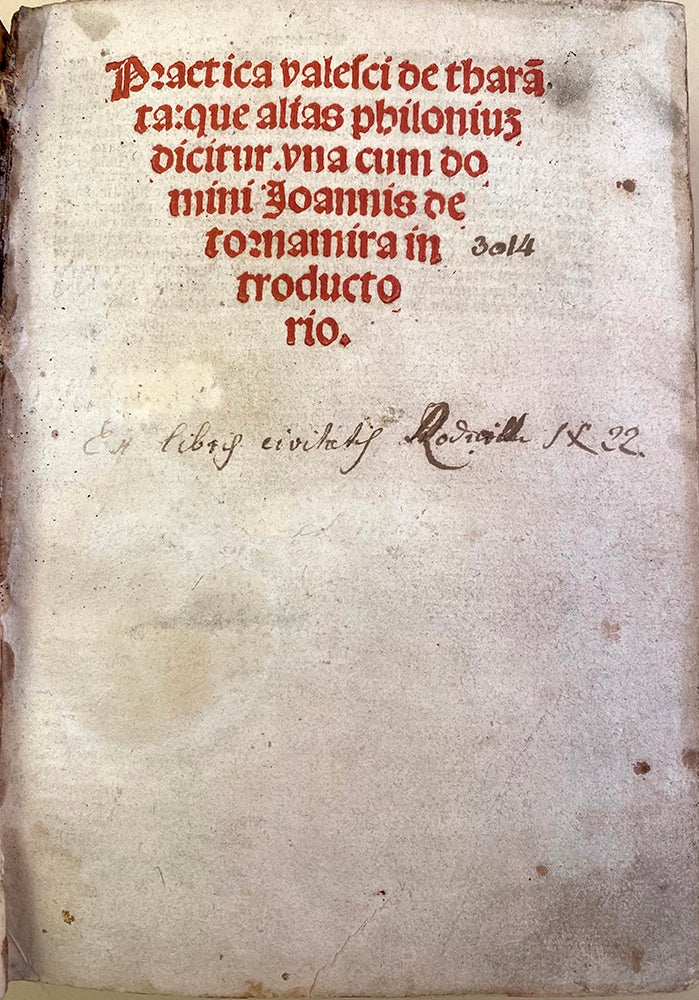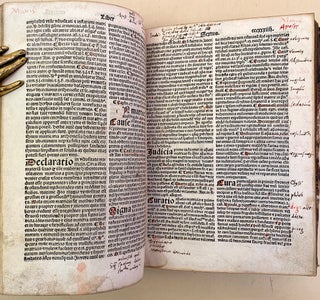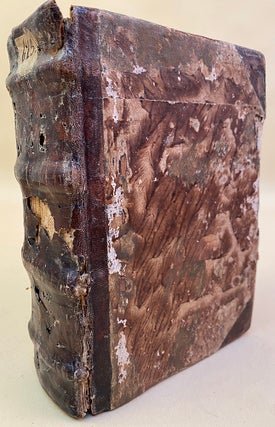Practica Valesci de Tharanta, que alias Philonium dicitur: una cum domini Joannis de Tornamira introductorio
Publisher Information: Lyon: Jacques Myt, 1516.
Valesco de Tarenta (fl. 1382-1418). Practica Valesci de Thara[n]ta: Que alias Philonius dicitur. Una cum domini Joannis de Tornamira introductio. 8vo. [8], 424pp. (paginated in roman numerals). Lyons: Jacobus Myt, 1516. 178 x 123 mm. Old half calf, paste paper boards, original clasps lacking, spine wormed and chipped, some wear. Light toning, first and last leaves somewhat soiled, but very good. Rubricated throughout with numerous marginal annotations in both red and black ink; manuscript index in what appears to be a 16th-century hand on the last two leaves. Old French library inscription on the title (“Ex libris civitatis Rouville”); 20th-century owner’s stamp on the front pastedown.
Later edition of Valesco de Tarenta’s 15th-century medical treatise, written circa 1418 and first published in print in 1484. This edition is rare; there are no auction records, and only six copies cited in OCLC (Stanford, Chicago, Rochest, LC, NLM, McGill). Valesco, a Portuguese-born physician, studied medicine in Montpellier, receiving his medical license (but not the master’s diploma) in 1387. He traveled extensively in Spain, Portugal and France before joining the household of the counts of Foix, where he remained for the rest of his life.
Valesco’s Practica (also known as the Philonium) “gives prominence to facts, and, in spite of its being mainly a compilation, evidences a sense of clinical observation and many therapeutic novelties” (Neuburger, History of Medicine, p. 95). The work “is unusual as an encyclopedic survey by an academically-trained physician who apparently never became a master or taught in the schools. A remarkable feature of the work is the number and variety of medical authorities it cites, not just Greco-Arabic sources but recent and even contemporary Latin practitioners as well, the latter almost all figures from the Montpellier tradition in which Valesco had been trained. These citations of recent authors may partly be a consequence of the enlarged medical literature in the fourteenth century, and of the size of his patrons’ library, but it may also reflect Valesco’s removal from an academic community, where professional jealousies were inevitable. Valesco is not hesitant to praise the practice—as distinct from the writings—of his own masters at Montpellier; of other masters there in his time, like François Conili and Jean Jacme . . . or of other practitioners of his acquaintance, like Guillem sa Garriga of Girona in Catalunya, not a physician but a surgeon.
“For, like Guy [de Chauliac], Valesco was a practitioner who cared little for the frontier between medicine and surgery. Book VII of the Philonium not only incorporates an independent treatise on surgery, it also includes separate discussion of a number of surgical topics of interest to its author, and one of these is hernia . . . his account of the traditional methods [of hernia treatment] often incorporates new elements which seem again to represent contemporary practice and innovations in technique” (M. McVaugh, “Treatment of hernia in the later Middle Ages: Surgical correction and social construction,” in French et al., Medicine from the Black Death to the French Disease (1998).
Book Id: 45942Price: $6,500.00





